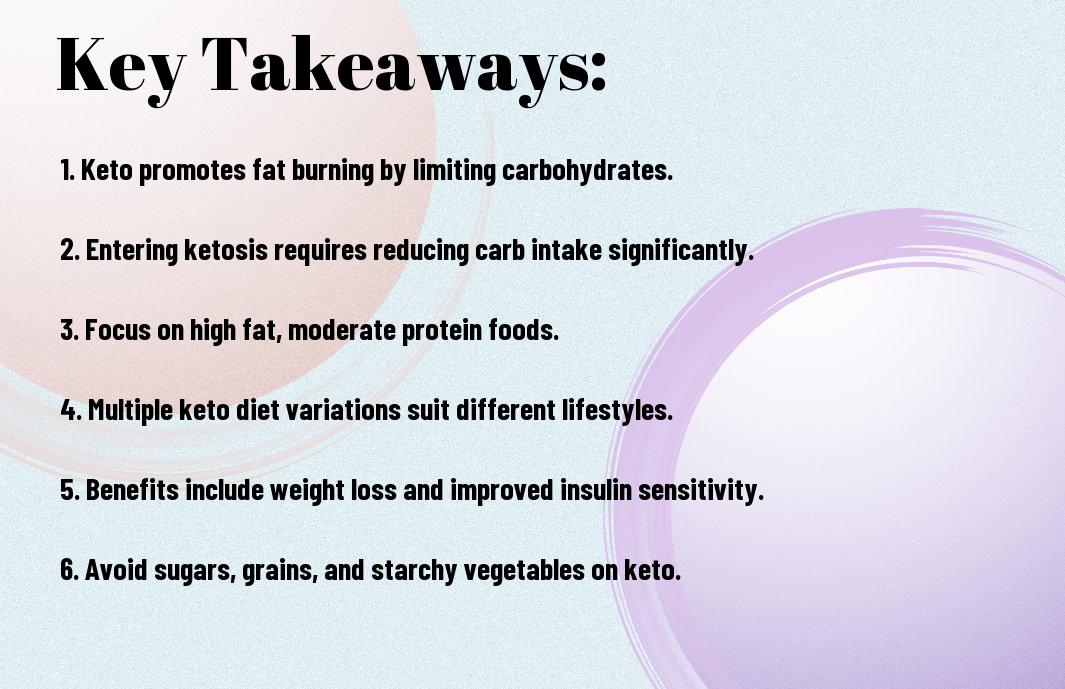Many newcomers to the world of the keto diet may feel overwhelmed by the rapid shift in dietary practices required to achieve success. This guide aims to equip you with the vital knowledge to navigate the fundamentals of keto, from understanding how your body transitions into ketosis to what foods you should embrace or avoid. By following these insights, you can harness the full range of health benefits that this low-carb, high-fat approach has to offer.


Basic Rules of the Keto Diet
Any successful journey on the keto diet requires adherence to a few fundamental rules. Focus on significantly reducing your carbohydrate intake while increasing your fat consumption. This shift puts your body into a metabolic state known as ketosis, where it efficiently burns fat for fuel. Balancing your meals around healthy fats, moderate protein, and minimal carbohydrates will aid in maintaining this state. Tracking your macronutrients can also enhance your keto experience and results.
Macronutrient Ratios
The ideal macronutrient ratios on the keto diet typically consist of about 70-75% fats, 20-25% protein, and only 5-10% carbohydrates. Adopting these ratios can effectively help you reach and maintain ketosis, promoting better energy levels and weight loss. Adjusting your macronutrient breakdown can optimize your keto journey and enhance numerous health benefits.
Types of Ketogenic Diets
Even within the keto framework, there are various types of ketogenic diets to consider based on your lifestyle and goals. Here are the primary types:
- Standard Ketogenic Diet (SKD)
- Cyclical Ketogenic Diet (CKD)
- Targeted Ketogenic Diet (TKD)
- High Protein Ketogenic Diet
- Modified Atkins Diet
Any of these options can be tailored to your preferences and physical activities, allowing for flexibility in your nutrition plan.
| Type | Description |
|---|---|
| SKD | Very low carb, moderate protein, high fat. |
| CKD | Higher carb days after a few days of keto. |
| TKD | Carbs consumed around workouts. |
| High Protein | More protein than standard keto ratios. |
| Modified Atkins | Similar to SKD but with more flexibility. |
A thorough understanding of the various types of ketogenic diets allows you to choose the one that best fits your needs. You may opt for the Standard Ketogenic Diet if you prefer a straightforward approach or the Targeted Ketogenic Diet if you’re active. This personalization ensures that you remain engaged and satisfied while pursuing your health goals.
- Standard Ketogenic Diet emphasizes consistent low carb intake.
- Cyclical Ketogenic Diet allows for planned high-carb refeed days.
- Targeted Ketogenic Diet is great to fuel workouts without breaking ketosis.
- High Protein Ketogenic Diet caters to those who love protein-rich foods.
- Modified Atkins Diet offers flexibility while still promoting ketosis.
Any of these ketogenic diet options can be effective when tailored to your lifestyle and health objectives.
| Type | Description |
|---|---|
| SKD | Low carb, moderate protein, high fat. |
| CKD | Includes refeed days for higher carb intake. |
| TKD | Adds carbs around workout sessions. |
| High Protein | Description describes a focused increase in protein. |
| Modified Atkins | A flexible approach for sustained ketosis. |
Understanding Ketosis
Assuming you are looking to harness the power of ketones for enhanced energy and weight loss, it’s necessary to grasp the concept of ketosis fully. This metabolic state occurs when your body shifts from using carbohydrates as its primary fuel source to burning fat instead. Achieving this transformation can lead to improved mental clarity, steady energy levels, and effective weight management, making it a fundamental aspect of the keto lifestyle.
Definition and Importance
Clearly, ketosis is a metabolic state where your body utilizes fat for fuel instead of carbohydrates. This shift not only aids in weight loss but also promotes various health benefits, including better blood sugar control and reduced hunger levels. By understanding how ketosis functions, you can better appreciate its significance in your keto journey.
Methods to Achieve Ketosis
Little adjustments in your diet and lifestyle can effectively guide you into ketosis. Primarily, you need to drastically reduce your carbohydrate intake while increasing your fat consumption. This prompts your body to seek alternative energy sources, leading it to burn fat and produce ketones. Additionally, incorporating intermittent fasting or increasing physical activity can expedite the process.
This method of achieving ketosis often involves limiting carbohydrate intake to around 20 to 50 grams per day, focusing on high-fat foods such as avocados, nuts, and fatty meats. It’s also beneficial to monitor your protein intake, as excess protein can convert to glucose, potentially hindering your entry into ketosis. Utilizing testing methods, such as blood or urine tests, can confirm your metabolic state, ensuring your keto efforts are on track.
Weight Loss Potential
Not all diets are created equal, and the ketogenic diet offers significant weight loss potential. By drastically reducing carbohydrate intake and promoting fat as your primary energy source, you may experience rapid weight loss. This initial phase can often yield quick results, largely attributed to the body’s shift into ketosis, making the keto diet appealing for those seeking efficient weight loss solutions.
Effectiveness Compared to Other Diets
Loss studies show that the ketogenic diet can be more effective for weight loss than traditional low-fat diets. The table below highlights key comparisons:
| Diet Type | Weight Loss Results |
| Ketogenic Diet | Often leads to greater initial weight loss |
| Low-Fat Diet | May result in slower weight loss |
Long-term Weight Management
Weight management can be challenging, but the keto diet may assist in maintaining your weight loss over time. By reprogramming your metabolism to rely on fat rather than carbohydrates, you can achieve greater satiety. This reduced hunger can help you sustain your weight loss achievements without the constant urge to snack.
Diets that emphasize fat consumption, like the keto diet, can lead to more sustainable weight management. As you reduce your carbohydrate intake, your appetite decreases, and your body becomes more efficient at burning stored fat. This shift can provide long-lasting changes, helping you avoid the cycle of yo-yo dieting typically associated with high-carb diets.
Benefits for Diabetes and Insulin Resistance
Unlike many traditional diets, the keto diet can significantly improve your health if you have diabetes or insulin resistance. It reduces carbohydrate intake, which helps lower blood sugar levels and enhances insulin sensitivity. By following this dietary approach, you may experience better overall metabolic health and weight management, key factors in managing diabetes effectively.
Impact on Blood Sugar Levels
Little changes in your diet can lead to significant reductions in blood sugar levels. By minimizing carbohydrate intake through the keto diet, you can stabilize your blood sugar and avoid the spikes and crashes often experienced with high-carb meals.
Studies on Diabetes Management
Clearly, research supports the effectiveness of the keto diet in managing diabetes. Numerous studies have shown that participants on a ketogenic diet often experience weight loss, improved insulin sensitivity, and better control over blood sugar levels.
Diabetes management is a vital concern for anyone navigating this condition. Evidence suggests that the keto diet can lead to more favorable outcomes compared to traditional dietary recommendations. For instance, studies indicate that individuals with type 2 diabetes following a ketogenic lifestyle can see a marked reduction in hemoglobin A1C—a key marker of long-term blood sugar control. With sustained adherence, you may also witness diminished reliance on medications and an overall enhancement in quality of life.
Other Health Benefits
Now that you’re exploring the keto diet, it’s important to note the numerous health benefits beyond weight loss. This dietary approach can support overall wellness, including better metabolic health, enhanced brain function, and improved insulin sensitivity, making it a favorable choice for many health-conscious individuals.
Neurological Conditions
Other studies reveal that the keto diet may offer therapeutic advantages for various neurological conditions. By reducing seizure frequency in epilepsy patients and potentially alleviating symptoms of Alzheimer’s, this diet highlights its role as a promising adjunctive treatment in these areas.
Cardiovascular Health
Health professionals are increasingly interested in how the keto diet can positively influence cardiovascular health. By emphasizing healthy fats while reducing carbohydrate intake, this diet may lower triglycerides, enhance HDL (good) cholesterol levels, and reduce blood pressure, all crucial factors for heart health.
Plus, adopting a keto lifestyle can lead to significant improvements in the well-being of your cardiovascular system. Many individuals experience a decrease in harmful LDL cholesterol levels and an overall reduction in markers for inflammation, which can further enhance your heart health. It’s crucial to choose healthy fat sources, like avocados and nuts, to help you achieve these impressive benefits while following the keto diet.
Foods to Avoid
Keep in mind that certain foods can hinder your progress on the keto diet. You’ll want to minimize your intake of high-carb foods, such as grains, sugary snacks, and starchy vegetables. These items can significantly impede your ability to enter or maintain ketosis, impacting your overall health journey.
High-Carb Food Items
While you explore your options on the keto diet, it’s vital to steer clear of high-carb food items. Foods like bread, pasta, rice, and sugary treats can easily exceed your carb limits, making it difficult to achieve the metabolic state necessary for utilizing fat as your primary energy source.
Processed Foods and Sugars
Food that contains processed sugars should also be eliminated from your diet. These include soft drinks, sugary snacks, and even so-called “diet” products that often contain hidden sugars and carbs. They can spike your blood sugar levels, undermining the benefits of your keto efforts.
Any processed foods or sugars can lead to unwanted fluctuations in your blood sugar levels and may sabotage your keto journey. These items often contain hidden sugars and unhealthy fats that impact your health negatively. By avoiding them, you can better regulate your energy levels and make the most of your ketogenic lifestyle.

Recommended Foods
After embracing the keto lifestyle, it’s crucial to focus on foods that align with your dietary goals. Eating the right foods ensures you stay in ketosis and experience the full range of benefits. Prioritize whole, nutrient-dense options that are low in carbs and high in healthy fats. This not only supports your weight loss journey but also enhances overall wellness. Stock your kitchen with a variety of meats, healthy fats, and low-carb vegetables to make your meal planning easier and more enjoyable.
Low-Carb Protein Sources
Protein sources in the keto diet are vital for maintaining muscle mass while burning fat. Opt for high-quality options like grass-fed beef, free-range poultry, and wild-caught fish. Eggs are another excellent choice as they are nutrient-rich and versatile. Incorporating these protein sources into your meals will help you feel satisfied without exceeding your carb limit.
Healthy Fats and Vegetables
With the keto diet, it’s important to include healthy fats and non-starchy vegetables in your meals. This combination not only provides crucial nutrients but also keeps your energy levels steady. Fats like avocados, olive oil, and nuts are fantastic choices that enhance flavor and fullness. Pair these healthy fats with low-carb vegetables such as leafy greens, broccoli, and zucchini to create balanced and satisfying meals.
Foods that are rich in healthy fats and low in carbohydrates will support your keto journey. Incorporating avocados, olive oil, and coconut oil will provide your body with necessary energy while remaining within your carbohydrate limits. Additionally, non-starchy vegetables offer vitamins, minerals, and fiber, making them perfect accompaniments to your meals. By focusing on a variety of these foods, you ensure your nutrition is on point while enjoying delicious, hearty dishes.
Sample Meal Plan
Once again, crafting a sample meal plan can be a helpful way to visualize your day on the keto diet. A successful plan typically includes a balance of high-fat foods with moderate protein, all while keeping carbohydrates to a minimum. This approach not only keeps meals exciting but also supports your transition into ketosis, helping you to achieve your health goals efficiently.
Daily Meal Examples
Examples of daily meals on the keto diet could include options like scrambled eggs cooked in butter topped with avocado for breakfast, a salad with grilled chicken and olive oil dressing for lunch, and a delicious dinner of salmon with asparagus sautéed in garlic. Each meal focuses on high-fat ingredients while keeping carbs low.
Snack Recommendations
Any good keto meal plan includes tasty snacks to keep your energy levels up throughout the day. You might consider snacks like nuts, cheese, hard-boiled eggs, or slices of avocado. These options are not only satisfying but also easy to prepare and carry with you for on-the-go munching.
Sample snacks for your keto diet should be low in carbohydrates while being rich in healthy fats and protein. For instance, you could enjoy a handful of almonds, a piece of string cheese, or even vegetable sticks dipped in guacamole. Having these snacks readily available can help you avoid high-carb temptations, keeping you on track with your dietary goals.
Tips for Success
All newcomers to the keto diet can benefit from some key strategies to enhance their journey. Here are some tips to ensure your success:
- Plan your meals in advance.
- Track your macros to stay within your carb limits.
- Stay hydrated and consider electrolyte supplementation.
- Experiment with recipes to keep meals exciting.
- Seek support from online communities or friends.
The right approach can significantly improve your results on the keto diet.
Common Pitfalls to Avoid
Little mistakes can derail your progress while following the keto diet. Be cautious of hidden sugars in processed foods, overeating protein, or not consuming enough fats, which are imperative for achieving ketosis. Staying informed and making mindful choices can help you steer clear of these traps.
Strategies for Dining Out
Little adjustments can make dining out easier while adhering to your keto lifestyle. When visiting a restaurant, choose meat or fish dishes and ask for vegetables or salad instead of starchy sides. Avoid bread and sauces that may contain sugar.
Dining out on the keto diet requires a proactive approach. Investigate menus online before going to identify suitable options. Communicate your dietary needs to the server, as most restaurants are accommodating. Request modifications, such as grilled instead of fried, and ask for dressings on the side to control your carb intake. Enhancing your awareness during dining experiences can help you stay aligned with your keto goals.
Side Effects and Risks
To launch on a ketogenic diet, it’s important to be aware of potential side effects and risks associated with it. Some individuals may experience symptoms such as headaches, fatigue, and dizziness during the initial adjustment phase. These effects are often referred to as the “keto flu” and can be managed with proper hydration and electrolyte balance.
Short-Term Side Effects
With the transition into ketosis, you may encounter a variety of short-term side effects. Common complaints include fatigue, irritability, and digestive issues as your body adapts to a significantly reduced carbohydrate intake. These symptoms typically subside within a few days to weeks as your body adjusts to burning fat for fuel.
Long-Term Health Considerations
Risks associated with long-term adherence to the keto diet may include nutrient deficiencies, liver problems, and possible increased cholesterol levels. It’s vital to monitor your health and consult a healthcare professional to ensure you’re meeting your nutritional needs while following the diet.
To mitigate health risks associated with long-term keto adherence, you should prioritize a variety of nutrient-dense foods within the allowed categories. Incorporating leafy greens, non-starchy vegetables, and adequate protein sources can help you maintain overall health while fulfilling your dietary requirements. Regular check-ups and blood work will allow you to stay informed about your health and make necessary adjustments to your diet.
Supplements for Keto
Your journey on the keto diet can be enhanced with the right supplements. While whole foods should be your primary source of nutrients, certain supplements can help fill any gaps and support your body during this low-carb lifestyle. Key supplements may assist in maintaining your energy levels and optimizing your overall health on this diet.
Recommended Supplements
Supplements such as MCT oil, fish oil, and exogenous ketones can benefit your keto experience. MCT oil provides a quick source of energy, while fish oil supports heart health. Exogenous ketones can help elevate your ketone levels and provide additional fuel, especially during the transition into ketosis.
Role of Electrolytes
Assuming you’re on the keto diet, managing your electrolyte levels is crucial. A lower carbohydrate intake often leads to a decrease in insulin levels, causing kidneys to excrete excess sodium and encouraging a loss of electrolytes such as potassium and magnesium.
Plus, ensuring adequate intake of electrolytes can help prevent common symptoms of the “keto flu,” which includes fatigue, headaches, and muscle cramps. Foods rich in potassium, such as leafy greens and avocados, along with magnesium-rich options like nuts and seeds, should be incorporated into your daily meals. Additionally, consider supplementing with sodium to maintain hydration and support overall light function as you adapt to your new keto lifestyle.
Frequently Asked Questions
Many beginners have questions about the keto diet, ranging from dietary restrictions to its impact on overall health. This section aims to address common inquiries and provide clarity on your keto journey, helping you to navigate potential challenges and optimize your results effectively.
Common Concerns
You may wonder if the keto diet is safe or if it can fit your lifestyle. Addressing these concerns involves understanding how the diet adjusts metabolic pathways and enables your body to utilize fat as an energy source, all while considering your individual health goals and needs.
Clarifying Misconceptions
Common misunderstandings about the keto diet could lead to hesitation. Many people believe it requires extreme food restrictions or a complete absence of carbohydrates. In reality, it focuses on drastically reducing carbohydrate intake while allowing for a variety of nutritious foods high in fats and moderate in protein. This balance is key to achieving and maintaining ketosis effectively.
Plus, it’s important to clarify that the keto diet doesn’t have to be a bland, restrictive approach to eating. By embracing a wide array of healthy fats, quality proteins, and even some low-carb vegetables, you can enjoy flavorful meals that support your health and weight loss objectives. The goal is to tune into your body’s signals while making informed choices tailored to your lifestyle.
To wrap up
To wrap up, as you commence on your journey with the keto diet, understanding the fundamentals of this low-carb, high-fat approach will empower you to make informed dietary choices. You will benefit from weight loss, improved insulin sensitivity, and various health advantages by focusing on healthy fats and minimizing carbohydrate intake. By being mindful of the foods you consume and utilizing this comprehensive guide, you’re setting yourself up for success on your keto adventure.


